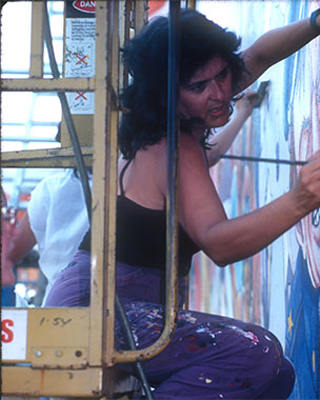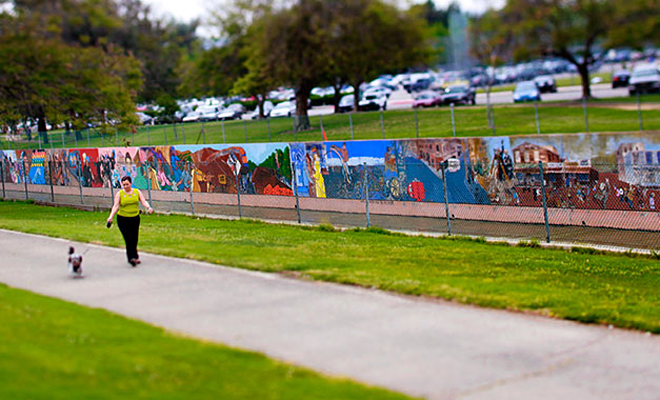The first pieces of art Judy Baca ever saw were in a church in Watts she attended as a little girl. She would sit in the pew and marvel at the imagery around her. And when her grandmother would take her on the trolley car to the Los Angeles Central Market, they would pass the 17 interconnected sculptural pieces that make up Simon Rodia’s Watts Towers, one of LA’s most iconic pieces of public art.

It was almost destiny, then, that she would become one of LA’s most treasured artists and an acclaimed muralist and teacher.
“It was a straight arrow from kindergarten through to university and the arts,” says Baca, a professor in both the UCLA Department of World Arts and Cultures and the university’s César E. Chávez Department of Chicana/o Studies. “Drawing and painting was the thing. It was always that.”
EARLY CAREER IN VENICE
After graduating from Cal State Northridge, Baca moved to the Westside and Venice, where she first began to use walls for “telling the stories of the people,” as she told KCET-TV in an interview. She referred to this approach as “the center of my work.”
Working with 30 artists, Baca painted 2,000 feet of mural in Venice, recreating the early days of the neighborhood developer and conservationist Abbot Kinney dreamed of turning into a Southern California version of its Italian namesake.
In 1974, Baca founded the first City of Los Angeles Mural Program, which evolved into a community arts organization known as the Social and Public Art Resource Center (SPARC). Two years later, she took on an ambitious public project at the invitation of the U.S. Army Corps of Engineers, which wanted to add murals and bike paths along the new flood control channels after nearly 60 miles of LA riverbed had been encased in concrete. This new project would come to be regarded as one of the most important pieces of public art in the city: The Great Wall of Los Angeles.
A NEW VIEW OF L.A. HISTORY
Running a half-mile along a concrete retaining wall of the Tujunga Wash Flood Control Channel in the San Fernando Valley, the Great Wall was built over seven summers. Baca envisioned a historical narrative depicting California and American history, but woven from the untold stories of often unrecognized ethnic groups that have shaped California’s history, starting with prehistoric times and running through the 1950s. It was the same simple but powerful concept — art made of, by and for the people — that powered the muralist’s extraordinary work in Venice, now spread large to encompass all of Los Angeles.
Baca pulled together hundreds of community members, artists, oral historians, ethnologists and other scholars to conceptualize and paint the mural. And she assembled a crew of novice muralists: teens from LA’s juvenile justice system, which also offered the project funding to support their rehabilitation. Ultimately, Baca would bring on some 400 young people, most from neighborhoods deeply divided by race and gang affiliation.
Baca’s young muralists also learned new lessons in history as they painted scenes showing, among other things, the decimation of thousands of indigenous people in epidemics at Mission San Fernando in Mexico and its sister missions up and down the coast. The teens heard firsthand from Great Wall consultants like Ami Ishii, who shared stories about her Japanese-American family’s relocation during World War II to the Manzanar internment camp. Her stories would form the basis for Great Wall scenes about that period and the history of Japanese-Americans in California.
But by 2011, nearly four decades of blazing-hot sunshine, smog, flash floods and infestation by burrowing trapdoor spiders had taken their toll on the Great Wall. Naturally, Baca stepped up to the restoration effort. As always, her community stepped up with her. And a new generation of muralists learned about the connection between art and community.
Among those working on the restoration were many students in Baca’s Beyond the Mexican Mural class, which incorporates both academics and actual work on a public artwork. Part of their UCLA training takes place in the César E. Chávez Digital/Mural Lab at SPARC’s Venice headquarters. Baca and her students have created a number of acclaimed artworks, among them, the world’s largest monument to César Chávez at San Jose State University.
Baca continues to serve as SPARC’s artistic director and focuses her creative energy in the UCLA@SPARC Digital/Mural Lab, employing digital technology to create social justice art. And work is underway on a project for the Los Angeles Department of Cultural Affairs to create a new mural in commemoration of the Watts Riots/Rebellion of 1965.
But neither Baca nor the people of Los Angeles will ever forget the power of her Great Wall.
“Everyone,” she says, “finds a piece of themselves in it.”

